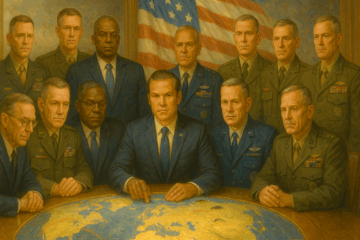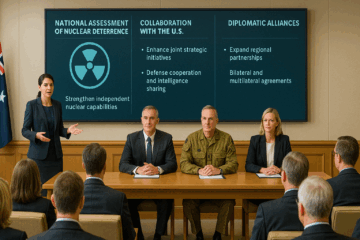President Donald J. Trump made it a priority for the United States to midwife a ceasefire and peace agreement between Ukraine and Russia. Europeans, including members of the North Atlantic Treaty Organization (NATO) and the European Union, reacted with mixed feelings. They agree that the horrible carnage in Ukraine should come to an end. But some Europeans are concerned that Trump will pressure Ukrainian President Volodymyr Zelensky to make premature or unnecessary concessions to Russian President Vladimir Putin. A bad deal from Ukraine’s standpoint will make it less able to defend itself in the aftermath of any peace agreement, and there is no assurance that Putin will desist his efforts to undermine Ukrainian sovereignty and territorial integrity.
Given these doubts, European political leaders have expressed a determination to increase their defense budgets and upgrade their armed forces and defense industrial bases. For example, European Community leaders met in early March to discuss the urgency of rearmament and the possible shift in American commitment to the defense of Ukraine and/or Europe altogether. The president of the European Commission noted that Europe faces a “clear and present danger” from the possibility of an asymmetrical peace agreement favorable to Russia followed by a more ambiguous American commitment to the defense of Europe.
European concerns are understandable, but the possibility that free Europe can establish a self-sufficient deterrent against further Russian political coercion or military aggression, apart from US security guarantees, is remote. An effort to bisect American national security from that of Europe would be politically unwise, weaken deterrence, and open the door to piecemeal disintegration of the transatlantic partnership that served leaders during the Cold War and thereafter. Four aspects of this issue merit specific consideration.
First, NATO is the strategic and military embodiment of shared security commitment and risk among member-states. NATO’s totality of conventional and nuclear military strength, supported by its political unity, is the linchpin for credible deterrence against Russian revanchism. Collectively, NATO members have the resources, including conventional forces for modern combined arms battle and the defense industrial base for protracted conflict, to deter any repetition of Russia’s invasion against Ukraine or any Russian attack on the alliance. American commitment to European defense ensures that its strategic nuclear forces support deterrence across the entire spectrum of conflict, including possible Russian nuclear political coercion or first use.
Second, President Trump, on his best and worst days, tends to see international relations as entirely transactional. This may work when dealing with trade or tariff matters but not matters of war and peace. American entanglement with the security of Europe is not only transactional; it is also existential. European and American defense and deterrence requirements are joined at the hip, notwithstanding occasional spats and acrimony over the details of military planning and defense economic priorities. American politicians complain that the United States should try to avoid getting stuck in another “forever war” in Ukraine but Ukraine is not Iraq or Afghanistan.
A victory for Putin in Ukraine opens the door to European vulnerability that Russia will later exploit at a higher cost in blood and treasure for the United States and its European partners.
Therefore, it follows that the US decision in early March to suddenly suspend American military assistance and intelligence sharing with Ukraine was ill advised and poorly timed. Although holding back equipment deliveries might take some months to impact events at the front, failure to share timely intelligence could impact immediately on Ukraine’s ability to strike key Russian targets, including logistics hubs, command centers, and troop concentrations. Thus, the suspension sent the wrong message to Ukraine and to Russia about allied steadfastness as preliminary ceasefire and peace negotiations were taking place in Saudi Arabia.
Third, messaging of American commitment to peace and security in Europe also involves the decisions about modernization of the American nuclear deterrent and supporting infrastructure. This has a number of components. First, the US is replacing all three legs of its strategic nuclear triad. The Trump administration also wants to deploy the sea-launched cruise missile, to replace some existing nuclear warheads with upgrades, and to provide additional limited nuclear options for contingencies short of general nuclear war.
Fourth, American defense planning for each potential theater of war will continue to emphasize a spectrum of options including both conventional and nuclear weapons. The US must maintain credible deterrence against the combined forces of China and Russi, not only with respect to the possible outbreak of conventional war in Asia or Europe, but also with regard to the threat of nuclear first use or first strike against American allies or the American homeland.
In this respect, another challenge to deterrence lies in the increasing capability of conventional weapons for use against targets previously assigned to nuclear weapons, and, conversely, the attractiveness for some parties of low-yield nuclear weapons for use against targets previously assigned only to conventional weapons.
The challenges in meeting the preceding standards for deterrence in Europe and beyond are enormous. First, they include the evolving international security environment in which an emerging multipolar realignment places a coalition of China, Iran, North Korea, and Russia at cross-purposes with US and allied visions for world order in Europe and Asia. Second, the challenges involve the significance of emerging technologies for long-range precision strike, missile and air defenses, cyber deterrence and war, space conflict, and continuing developments in autonomous warfare. Third, the costs for maintaining deterrence in Asia and Europe are enormous and Europe cannot expect the United States to foot the bill.
Some American allies in Asia and Europe expressed a willingness to increase their defense budgets and their degrees of readiness for local or regional conflict. More demanding times are ahead. In short, there is no “Eurodeterrent” without the United States and vice versa.
Stephen Cimbala, PhD, is a distinguished professor at Penn State-Brandywine and a Senior Fellow at the National Institute for Deterrence Studies.
About the Author

Stephen Cimbala
Dr. Stephen Cimbala is Distinguished Professor of Political Science at Penn State university, Brandywine. He is currently a senior fellow with the National Institute for Deterrence Studies.




